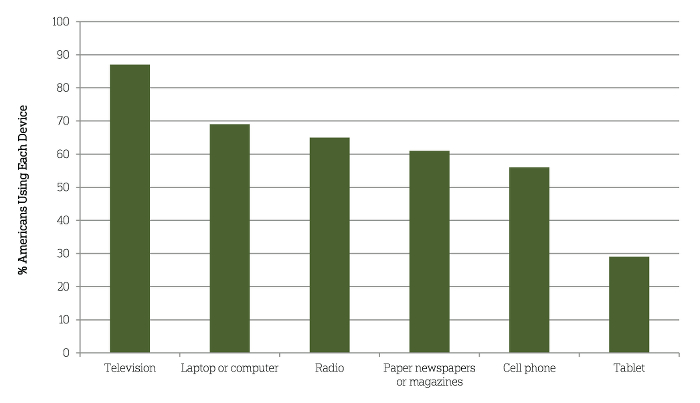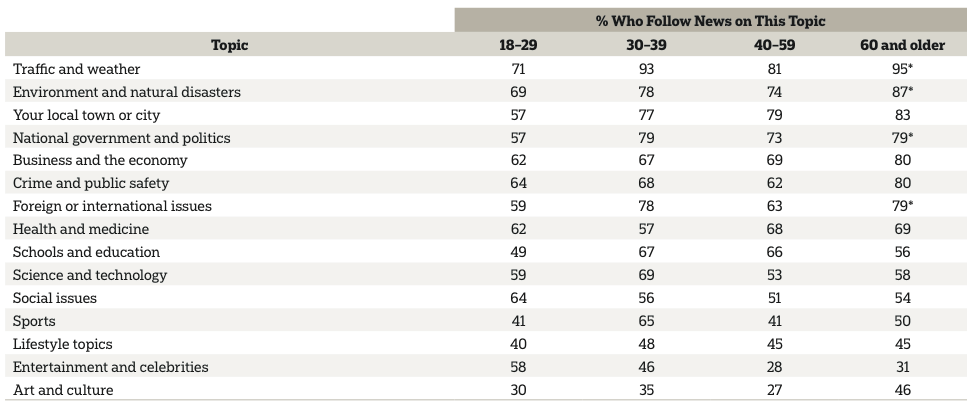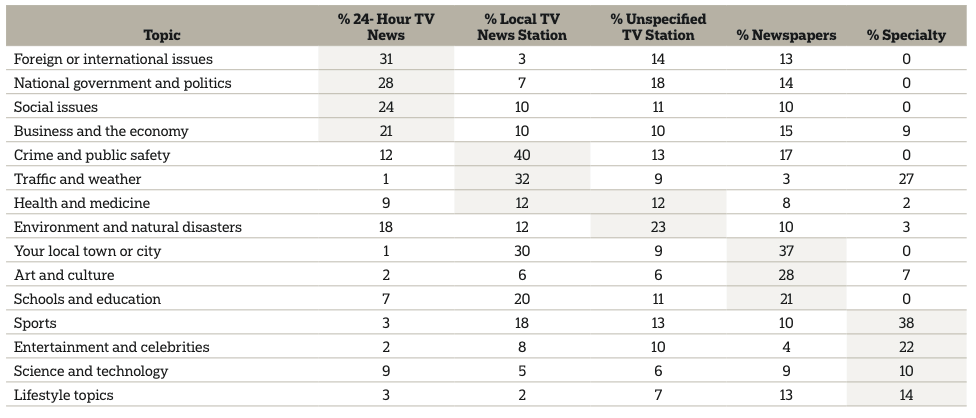This research was conducted by the Media Insight Project — an initiative of the American Press Institute and the Associated Press-NORC Center for Public Affairs Research
Introduction
Contrary to the conventional wisdom about media consumption dividing along generational or political lines, a new survey finds that the nature of the news itself — the topic and speed of the story — largely determines where people go to learn about events and the path they take to get there.
The findings also suggest that some long-held beliefs about people relying on just a few primary sources for news are now obsolete.
In contrast to the idea that one generation tends to rely on print, another on television and still another the web, the majority of Americans across generations now combine a mix of sources and technologies to get their news each week, according to the survey by the Media Insight Project, an initiative of the American Press Institute and the Associated Press-NORC Center for Public Affairs Research.
Where people go for news, moreover, depends significantly on the topic of the story — whether it is sports or science, politics or weather, health or arts — and on the nature of the story — whether it is a fast-moving event, a slower-moving trend, or an issue that the person follows passionately.
The data also challenge another popular idea about the digital age, the notion that with limitless choices people follow only a few subjects in which they are interested and only from sources with which they agree — the idea of the so-called “filter bubble.”
There are relatively few differences by generation, party, or socioeconomic status in the level of interest with which people report following different topics.
These are some of the findings of the nationally representative telephone survey of 1,492 adults conducted from January 9 through February 16, 2014.
The data from the survey, which was designed to probe what adults distinguish most in their news consumption in the digital age, offer a portrait of Americans becoming increasingly comfortable using technology in ways that take advantage of the strengths of each medium and each device.
There are five devices or technologies that majorities of Americans use to get news in a given week. The average American adult uses four different devices or technologies for news.
Three-quarters of Americans get news at least daily, including 6 out of 10 adults under age 30.

Question: “Please tell me if you used each device or technology to get new in the last week, or if you did not.”
Nearly half of Americans with internet access have signed up for news alerts.
And the rapid growth in mobile technology is changing the mix. Among smartphone owners, 78 percent report using their device to get news in the last week. Seventy-three percent of tablet owners use their device to get news. And people with more devices tend to enjoy following the news more. News consumers who use more technology are more likely to report that they enjoy keeping up with the news and are more likely to say that it’s easier to keep up with the news today than it was five years ago.
At the same time, these tech-savvy news consumers continue to use traditional platforms as well. For example, they are no more or less likely than everyone else to use print publications, television, or radio to access the news.
But there is a strong correlation between mobile technology and social media and various other digital activities. Smartphone owners, for instance, are two and half times as likely to get news through social media as those without smartphones, twice as likely to use search engines and aggregators for news and to get news alerts, and more than twice as likely to share news. Patterns are similar for tablet owners as well.
Not only do people consume news from many different devices, nearly half say they have no one preferred means of doing so. Furthermore, people access different reporting sources on a regular basis. When asked about their use of eight different reporting sources in the last week, Americans report using an average of between four and five sources.
That contrasts starkly with the long-held idea that news habits are strictly ingrained and often limited to a few primary sources.
Similarly, there are only small differences across age, political party, or socioeconomic status in the news topics people follow. For example, the percentage of people who say they follow news about local affairs, business and the economy, health and medicine, schools and education, and social issues, among other topics, differs little by generation. And, even for topics where younger news consumers are less avid followers than their elders, they still report high levels of interest. Adults age 18–29, for instance, are less inclined than those 60 and over to follow news about national government (57 percent vs. 79 percent) or foreign affairs (59 percent vs. 79 percent overall), but majorities of both age groups still do so.

Question: Please tell me whether you personally try to keep up with news about each topic or not.
*Indicates a significant difference from the 18–29 age group.
Another striking finding is that how Americans seek out the news changes markedly with the subject matter. When asked where they go for news on each topic, people are most likely to use specialized sources now to learn about 4 of the 15 topics probed: sports, entertainment, science and technology, and lifestyle news. They are most likely to turn to local TV for weather, traffic, crime, and health news.
People turn to newspapers, whether in print or online, more than any other source specified, and in relatively high numbers for a wide range of topics (double-digit percentages for 11 of the 15 topics discussed). But they are most likely to turn to newspaper media for news about their local town or city, for news about arts and culture, and for news about schools and education.
The 24-hour cable channels, by contrast, have little draw for some topics — such as health, arts, sports, or science. But they are the source most often cited for four of the topics probed: politics, international news, business and the economy, and social issues.
The survey sought to examine whether people distinguish between a reporting source — that is, the news organization that gathered the news — from the means by which they discovered the news — social media or a search engine, for instance — and what device they used — for example, print publications or smartphones. When asked to volunteer how they came to the news, people tend think less about the device than the news gathering source and the means of discovery (social media or search). Taken in combination, the findings suggest that people make conscious choices about where they get their news and how they get it, using whatever technology is convenient at the moment.
Overall, for instance, social media is becoming an important tool for people across all generations to discover news—but hardly the only one, even for the youngest adults. Fully 4 in 10 Americans say they got news in the last week from social media, through platforms such as Twitter or Facebook.
The use of social media does vary by age group: 7 in 10 adults under age 30 say they learned news through social media in the last week, 6 in 10 of those age 30-39, 4 in 10 age 40-59 and 1 in 5 for those 60 or older. Social media, in other words, has become a significant part of the news consumption habits for many Americans across generations.
Yet social media appears to be largely adding to, rather than replacing, other ways that people get news. At the same time that 4 in 10 now use social media, more than 80 percent of Americans say they also got news in the last week by going directly to a news organization in some manner—and that was consistent across generations.
Even for the youngest adults, age 18-29, social media and the web in general have hardly replaced more traditional ways of getting the news. Nearly half of the youngest adults also read news in print during the last week, 3 in 4 watched news on television, and just over half listened to it on the radio.
People also view these different ways of learning the news with varied levels of skepticism. Americans of all generations are nearly three times as likely to express high levels of trust about what they learn directly from a news organization (43 percent say they trust it mostly or completely) as they are to trust what they discovered through social media (15 percent of those who used it to get news say they had high levels of trust in what they learned). And those numbers about trust for different ways of discovering the news do not vary much by generation.
The survey also probed whether people learned about different kinds of stories — breaking news, for instance, versus slower-moving trends — differently, or whether they tend to rely on the same sources and platforms regardless of the type of story. Much as people tailor how they find out about news and their go-to sources depending on the topic, they also adjust their behavior for the type of news they are following. For example, half of news consumers recalling a breaking news story they followed recently said they first heard about it on TV. About half of the people following a breaking news story report actively trying to learn more about that breaking news story. At that point, however, more people turned to the internet to follow the story than TV.
TV news reporting organizations are the most common source mentioned across all types of news, but especially so for breaking news, with 61 percent noting some type of TV news organization — including cable news, local news, or broadcast networks — as the source where they first heard about the last breaking news story they followed. For slower-moving news, there is more diversity in go-to news sources, with more frequent mentions of newspapers and specialty media.
Patterns of news consumption also vary little by political affiliation. Partisans act more like each other in terms of attentiveness to the news relative to independents. But, partisans do differ from each other when it comes to the types of news reporting sources they say they trust. Democrats are more trusting of news from the three broadcast networks and the newswires, while Republicans are more trusting of news from cable.
The generational breakdowns do indicate the path of future change. Younger adults are more likely to find news through web-based media. Younger people are three times more likely to discover news through social media than adults age 60 and older. Similarly, people under 40 are more likely than those 40 and over to discover news through internet searches and online news aggregators.
But people across all generations are most likely to discover news by going directly to a news organization, rather than letting the news come to them. Younger adults are more likely to express a preference for social media as a means of discovery. Fully 13 percent of adults under age 30 cite social media as their preferred way to find news, compared to 3 percent or less for all other age groups. For all groups, however, hearing directly from the reporting source is preferred.
In other ways, gender is a more significant determinant of news habits than age. Women, for instance, are more likely to share news and get it through social media, and to follow news about schools and health and lifestyle. Men are more likely to watch cable news and follow different subjects, including sports and foreign affairs.
In addition, many of the broad findings discussed in this report hold true across racial and ethnic groups. Nearly 9 in 10 Americans across all ethnic groups get news at least several times a week and enjoy following the news at similar levels. In future reports, The Media Insight Project will be releasing more detailed analysis and new data about the personal news cycle of different ethnic groups, including a close look at ethnic news, as part of this research series.
About the study
Many traditional surveys about media consumption are tied to using questions that were designed in the 1960s and 1970s, a time when television was emerging to challenge print. While these questions are helpful for tracking change over time, they were designed in an era when people tended to have a primary source for news they relied on. Those traditional questions also struggle with trying to sort out whether Americans, when they use a medium like social media or the internet, distinguish between the technology device they are using (phone or tablet), the platform or means of discovery (such as search or social media), and the source (the organization or reporting body that they are seeking out). Do people notice, for instance, when they are online, whose content they are consuming? When they use social media, to what extent, if at all, do they discriminate which links they click on?
This survey was designed to probe these questions and others.
When do people consume news today? Do they consume breaking news differently than they do slower-moving trend topics? After people hear about something happening, to what extent do they try to learn more? If they do, where do they go and how do they navigate there?
And to what extent does the topic of the news—say weather versus technology—alter how people consume news now that the consumer is largely in control?
To address these questions, the survey utilized a unique approach to investigating news-gathering habits. For each news topic (e.g., business news vs. traffic and weather) or type (e.g., breaking news, slow-moving trends, and news people feel passionately about), we asked respondents to tell us how they generally follow news about that topic. All verbatim responses were collected and then coded by the research team. Every response was coded along three dimensions:
- Device categorized the coded mentions of the device or technology the respondent used to get news. For example, watching TV, listening to the radio, reading the print version of a newspaper, or reading an article on a smartphone.
- Discovery method categorized the coded mentions of how the respondent found the news regardless of the device used. For example, hearing it directly from a news organization, seeing it on social media, or hearing about it through word-of-mouth.
- Source categorized the coded mentions of the organization that gathered the information and did the news reporting. For example, reporting done by local TV news stations, newspapers, online-only news sites like The Huffington Post, or magazines like Time.
Additionally, if a respondent did not mention one of these dimensions in their response about how they generally follow news, the dimension was coded as “no specific mention.” This coding scheme allowed the research team not only to quantify how people do get their news, but also to describe how people think about the news consumption and what dimensions are most salient in different news contexts.
One of the reasons for this approach is that it is less clear, now that people have so many choices, what consumers pay attention to when seeking out news. This has led to confusion in past data about what was meant by a news source versus a news platform, and it has made interpreting the data more difficult.
These distinctions are not only important for trying to understand behavior. They also are important to publishers who are trying to find the best ways to reach their audiences. They also matter to brand advertisers trying to figure out how to reach customers.
The margin of error for this telephone survey of 1,492 adults is +/- 3.6 percentage points. Interviews were completed with respondents on landlines and cell phones.
Share with your network
- The Personal News Cycle: How Americans choose to get their news
- How Americans get their news
- Social and demographic differences in news habits and attitudes
- Personal News Cycle study methodology and background
- Download the Personal News Cycle study report or topline results
- The rational and attentive news consumer
- Americans’ perceptions of the current news environment
You also might be interested in:
The two organizations will provide a series of monthly webinars to local media leaders and journalists in the months leading up to the 2024 U.S. elections, and share practical resources throughout the year to support news organizations’ evolving needs around local elections and democracy.
We challenge local news organizations to smartly deploy their resources around the elections that most matter to their communities in 2024 — and also to think about how that energy builds to something more robust and sustained.
Journalism has the power to connect our communities, to bring out the best in what our society can be. Our goal is to help us all get there.



